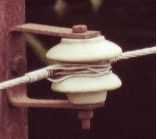The electrical insulator is a device that provides the necessary insulation between the conductor and the ground. The leakage current cannot flow from the line conductor to the earth because of the insulation. Insulators are commonly used for mechanical support and electrical safety in the overhead transmission lines, as well as in the distribution lines and substations.
What are the various types of insulators?
Types of Insulators
The common types of insulators are pin type, suspension type, strain insulator and shackle insulators.
Pin insulators:
The pin type insulator supports the conducting line in case of compression. Such insulators are used for electric power transmission and distribution at voltages of up to 33 kV. For transmit voltages up to 11 kV, a single-pin insulator is used, but higher voltages require two, three or four pin isolators. Pin-type insulators are mounted onto the transmission poles with steel or lead bolts and are typically used for straight transmission lines. However, these types of insulators become bulky and uneconomic over and above voltages of 33 kV.
The pin insulator has very simple construction as it is made of materials that have high mechanical strength. The horizontal and vertical orientation can be related to it. This requires less maintenance than other types of insulators.

Suspension insulators:
The suspension type of insulator is sometimes also called disc insulator. The suspension insulator is mainly made of sealed materials made of glass or porcelain. The suspension insulator voltage range is between 11 kV and 765 kV and can be mostly used in the overhead transmission system or line to provide more flexibility to the overhead lines.
It is usually placed alongside the steel tower. For supporting multiple disks, the suspension insulator needs more height and different disk voltage levels (low to high) can be used.
The suspension insulator on a transmission line is better than other insulators, as the remaining disk will work if any of the disks damage a suspension insulator. It is easy to replace the corrupted disk.

Strain or tension insulators:
Strain insulators are similar to the type of suspension insulator. The strain insulator can be used on the overhead transmission line, as is the suspension insulator. Nevertheless, the requirements and functions are somewhat different. The strain insulator is always perpendicular to the tower and parallel to the ground.
The strain insulators are usually used in higher voltage condition, above the 33 kV. It is usually used in the bend or arm location of the transmission line. Such insulators are designed to handle mechanical stresses at angle positions where there is a change in line direction or at the end of the line. For high-voltage lines with longer ranges and greater mechanical pressure, a suspension insulating string is arranged horizontally, which is known as tensile insulators. However, for higher conductor pressures, two or more strings may be deployed in tandem in situations where one single string is not sufficient to take the load.
There are also a variety of disc insulators that make up the strain insulators. The number of disk insulators required to make a strain insulator depends on the voltage of the line. If the voltage on the line is 33 kV then 3 isolators are used to make a strain insulator, if the voltage on the line is 66 kV then 6 isolators are used to create strain insulators and so on.
Shackle insulators:
The overhead distributed transmission is fitted with shackle insulators which are smaller in size. The metallic stripe is used for linking the shackle insulator in the distribution line.
This insulator can handle up to the voltage of 33 kV and can operate in the circular turn or bend position.
Shaken or spool insulators can be used in horizontal or vertical positions in lower voltage distribution networks. These insulators can work on sharp curves, end poles and segment poles just like strain-type insulators.
